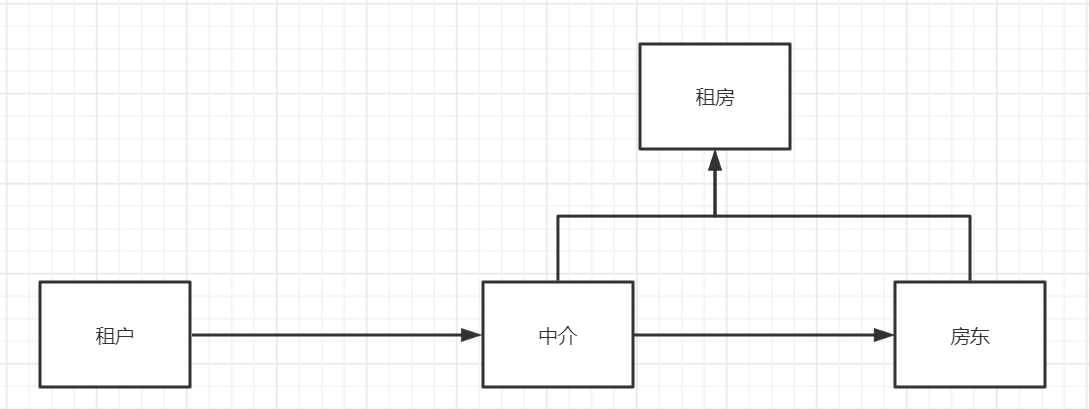spring——AOP(静态代理、动态代理、AOP)
一、代理模式
代理模式的分类:
- 静态代理
- 动态代理
从租房子开始讲起:中介与房东有同一的目标在于租房

1.静态代理
静态代理角色分析:
抽象角色:一般使用接口或者抽象类来实现(这里为租房接口)
public interface Rent {void rent();}
真实角色:被打理的角色(这里为房东)
public class HouseMaster implements Rent{public void rent() {System.out.println("房东租房啦!");}public static void main(String[] args) {HouseMaster houseMaster = new HouseMaster();Proxy proxy = new Proxy(houseMaster);proxy.rent();}}
代理角色:代理真实角色,代理真实角色后,一般会做一些附属操作
public class Proxy {HouseMaster houseMaster;public Proxy() {}public Proxy(HouseMaster houseMaster) {this.houseMaster = houseMaster;}public void rent(){lookHouse();houseMaster.rent();sign();}public void lookHouse(){System.out.println("看房子");}public void sign(){System.out.println("签合同");}}
客户:使用代理角色来进行一些操作
public static void main(String[] args) {HouseMaster houseMaster = new HouseMaster();Proxy proxy = new Proxy(houseMaster);proxy.rent();}
优点:
(1).真实对象更加纯粹,不在关注一些琐碎的公共事务
(2).公共业务由代理对象完成,有利于公共业务的扩展和管理
缺点:多了代理对象也增加了代码量(所以后面出现了动态代理模式)
动态代理
角色分析:与静态代理相同
特点:动态代理的动态类是动态生成的,不是我们直接写好的
分类:
(1).基于接口的动态代理——JDK动态代理(重点理解)
(2).基于类的动态代理——cglib
(3).javasist
核心api:
(1).Proxy:
Proxy提供了创建动态代理类和实例的静态方法,它也是由这些方法创建的所有动态代理类的超类。newProxyInstance(ClassLoader loader, 类<?>[] interfaces, InvocationHandler h):返回指定接口的代理类的实例,该接口将方法调用分派给指定的调用处理程序。
参数:
(1).loader类加载器
(2).代理对象的接口
(3).InvocationHandler的实体,因为一般是调用类继承了InvocationHandler,所以许多时候就是this
(2).InvocatioinHandler:
InvocationHandler是由代理实例的调用处理程序实现的接口 。每个代理实例都有一个关联的调用处理程序(也就是一个代理类)。 当在代理实例上调用方法时,方法调用将被编码并分派到其调用处理程序的
invoke方法。invoke
参数:
(1).proxy:调用该方法的代理实例
(2).method:所述方法对应于调用代理实例上的接口方法的实例
(3).args:参数,如果没有则为null
使用:
构建动态代理对象(这个代理对象可以用于同一个接口的多个实现类)
public class ProxyInvocationHandler implements InvocationHandler {//代理对象Object target;//设定动态代理的对象public void setTarget(Object target){this.target = target;}public Object getProxy(){return Proxy.newProxyInstance(target.getClass().getClassLoader(),target.getClass().getInterfaces(),this);}public Object invoke(Object proxy, Method method, Object[] args) throws Throwable {Object res = method.invoke(target, args);return res;}}
测试
public class service {public static void main(String[] args) throws Throwable {ProxyInvocationHandler handler = new ProxyInvocationHandler();handler.setTarget(new HostImpl());Host proxy = (Host) handler.getProxy();proxy.rent();}}
解释:从构建动态代理对象的过程查看
(1).设定动态代理对象:setTarget()
(2).获得动态代理getProxy()
(3).使用动态代理,表面上看是调用了proxy.rent,本质上还是调用handler实现的invoke函数,注意该函数的第一个参数proxy用处不大
优点:在静态代理的基础上,静态代理是代理的是一个类;而动态代理是代理一个接口(多个类)
二、AOP
AOP:面向切面编程,通过预编译方式和运行期动态代理实现 程序功能的统一维护的一种技术
导入织入包
两种方式:
使用api接口
(1).MethodBeforeAdvice:方法的前置增强
(2).AfterReturningAdvice:方法的后置增强
环境搭建:
//接口public interface service {void say();}//实例public class serviceImpl implements service {public void say() {System.out.println("say some thins");}}//前置增强public class beforeSay implements MethodBeforeAdvice {public void before(Method method, Object[] objects, Object o) throws Throwable {System.out.println("Good Morning!");}}//后置增强public class afterSay implements AfterReturningAdvice {public void afterReturning(Object o, Method method, Object[] objects, Object o1) throws Throwable {System.out.println("后置增强");}}
配置文件:
<?xml version="1.0" encoding="UTF-8"?><beans xmlns="http://www.springframework.org/schema/beans"xmlns:xsi="http://www.w3.org/2001/XMLSchema-instance" xmlns:aop="http://www.springframework.org/schema/aop"xsi:schemaLocation="http://www.springframework.org/schema/beanshttps://www.springframework.org/schema/beans/spring-beans.xsdhttp://www.springframework.org/schema/aophttps://www.springframework.org/schema/aop/spring-aop.xsd"><bean id="serviceImpl" class="com.guan.dao.serviceImpl"/><bean id="beforeSay" class="com.guan.dao.beforeSay"/><bean id="afterSay" class="com.guan.dao.afterSay"/><aop:config><!-- choose pointCut--><!-- public method.(args)--><aop:pointcut id="point" expression="execution(* com.guan.dao.service.*(..))"/><aop:advisor advice-ref="beforeSay" pointcut-ref="point"/><aop:advisor advice-ref="afterSay" pointcut-ref="point"/></aop:config></beans>
注:
(1).
<aop:point>设定切入点(2).
<aop:advisor>设定环绕对象(主要设定前置函数,后置函数及其目标的切入点)(3).
execution(* com.guan.dao.service.*(..))execution(* com.guan.dao.*.*(..)):所有修饰符(public,private) com.guan.dao包下的所有类下的所有方法的所有参数测试:
public static void main(String[] args) {ApplicationContext context = new ClassPathXmlApplicationContext("applicationContext.xml");service bean = context.getBean("serviceImpl", service.class);bean.say();}
注:这里返回的必须用接口类型(service),而不能用serviceImpl
使用切面
环境搭建:package com.guan.dao;public class Advice {public void before(){System.out.println("before");}public void after(){System.out.println("after");}}
配置文件:
<?xml version="1.0" encoding="UTF-8"?><beans xmlns="http://www.springframework.org/schema/beans"xmlns:xsi="http://www.w3.org/2001/XMLSchema-instance" xmlns:aop="http://www.springframework.org/schema/aop"xsi:schemaLocation="http://www.springframework.org/schema/beanshttps://www.springframework.org/schema/beans/spring-beans.xsdhttp://www.springframework.org/schema/aophttps://www.springframework.org/schema/aop/spring-aop.xsd"><bean id="advice" class="com.guan.dao.Advice"></bean><bean id="serviceImpl" class="com.guan.dao.serviceImpl"></bean><aop:config><aop:aspect ref="advice"><aop:pointcut id="point" expression="execution(* com.guan.dao.serviceImpl.*(..))"/><!-- 切面--><aop:before method="before" pointcut-ref="point"></aop:before><aop:after method="after" pointcut-ref="point"></aop:after></aop:aspect></aop:config></beans>
测试类:
public static void main(String[] args) {ApplicationContext context = new ClassPathXmlApplicationContext("applicationContext.xml");service bean = context.getBean("serviceImpl", service.class);bean.say();}//同上
注:
(1).注意
<aop:aspect>的ref是相关的构成切面的类(2).在这个类的内部还是需要切入点的
使用api接口和使用切面比较
(1).使用api接口需要记录相关的文档,但使用切面则可以在xml文件中直接配置
(2).使用api接口需要多个类继承相关的接口,而使用切面只需要一个类承载相关的方法即可
(3).使用api接口由于有对切入点的结果关联,所以和上下文的关联更密切;使用切面则切面的函数与切入点的上下文关系是割裂的
使用注解使用AOP
相关注解:
(1).@Aspect:标注这个类是一个切面
(2).@Before("切入点")
(3).@After("切入点后")
(4).@Around:功能复杂,需要相关的方法使用ProceedingJoinPoint类型的参数,且这个参数可以直接调用方法
(5).@EnableAspectJAutoProxy:用于注解开启注解(不用xml配置
<aop:aspectj-autoproxy/>)注意:切入点都要用execution表达式
环境搭建:
@Aspectpublic class AnnotationCutPoint {@Before("execution(* com.guan.dao.*.*(..))")public void before(){System.out.println("before");}@After("execution(* com.guan.dao.*.*(..))")public void after(){System.out.println("after");}@Around("execution(* com.guan.dao.*.*(..))")public void around(ProceedingJoinPoint joinPoint) throws Throwable {System.out.println("around1");joinPoint.proceed();System.out.println("around2");}}
注意:先要有切面@Aspect,才有切点
<?xml version="1.0" encoding="UTF-8"?><beans xmlns="http://www.springframework.org/schema/beans"xmlns:xsi="http://www.w3.org/2001/XMLSchema-instance" xmlns:aop="http://www.springframework.org/schema/aop"xsi:schemaLocation="http://www.springframework.org/schema/beanshttps://www.springframework.org/schema/beans/spring-beans.xsdhttp://www.springframework.org/schema/aophttps://www.springframework.org/schema/aop/spring-aop.xsd"><bean id="serviceImpl" class="com.guan.dao.serviceImpl"></bean><bean id="annotation" class="com.guan.dao.AnnotationCutPoint"></bean><aop:aspectj-autoproxy/></beans>
测试:
public class serviceImpl implements service {public void say() {System.out.println("say some thins");}public static void main(String[] args) {ApplicationContext context = new ClassPathXmlApplicationContext("applicationContext.xml");service bean = context.getBean("serviceImpl", service.class);bean.say();}}
注:spring的AOP默认是通过jdk生成,但也可以进行修改
<!-- jdk,默认--><aop:aspectj-autoproxy proxy-target-class="false"/><!-- cglib--><aop:aspectj-autoproxy proxy-target-class="true"/>
spring——AOP(静态代理、动态代理、AOP)的更多相关文章
- 【spring基础】AOP概念与动态代理详解
一.代理模式 代理模式的英文叫做Proxy或Surrogate,中文都可译为”代理“,所谓代理,就是一个人或者一个机构代表另一个人或者另一个机构采取行动.在一些情况下,一个客户不想或者不能够直接引用一 ...
- Spring AOP实现原理-动态代理
目录 代理模式 静态代理 动态代理 代理模式 我们知道,Spring AOP的主要作用就是不通过修改源代码的方式.将非核心功能代码织入来实现对方法的增强.那么Spring AOP的底层如何实现对方法的 ...
- Spring Boot实践——Spring AOP实现之动态代理
Spring AOP 介绍 AOP的介绍可以查看 Spring Boot实践——AOP实现 与AspectJ的静态代理不同,Spring AOP使用的动态代理,所谓的动态代理就是说AOP框架不会去修改 ...
- Spring AOP中的动态代理
0 前言 1 动态代理 1.1 JDK动态代理 1.2 CGLIB动态代理 1.2.1 CGLIB的代理用法 1.2.2 CGLIB的过滤功能 2 Spring AOP中的动态代理机制 2.1 ...
- 转:Spring AOP中的动态代理
原文链接:Spring AOP中的动态代理 0 前言 1 动态代理 1.1 JDK动态代理 1.2 CGLIB动态代理 1.2.1 CGLIB的代理用法 1.2.2 CGLIB的过滤功能 2 S ...
- spring---aop(4)---Spring AOP的CGLIB动态代理
写在前面 前面介绍了Spring AOP的JDK动态代理的过程,这一篇文章就要介绍下Spring AOP的Cglib代理过程. CGLib全称为Code Generation Library,是一个强 ...
- 【Spring Framework】Spring入门教程(五)AOP思想和动态代理
本文主要讲解内容如下: Spring的核心之一 - AOP思想 (1) 代理模式- 动态代理 ① JDK的动态代理 (Java官方) ② CGLIB 第三方代理 AOP概述 什么是AOP(面向切面编程 ...
- 转:AOP与JAVA动态代理
原文链接:AOP与JAVA动态代理 1.AOP的各种实现 AOP就是面向切面编程,我们可以从以下几个层面来实现AOP 在编译期修改源代码 在运行期字节码加载前修改字节码 在运行期字节码加载后动态创建代 ...
- AOP与JAVA动态代理
1.AOP的各种实现 AOP就是面向切面编程,我们可以从以下几个层面来实现AOP 在编译期修改源代码 在运行期字节码加载前修改字节码 在运行期字节码加载后动态创建代理类的字节码 2.AOP各种实现机制 ...
- 8、Spring教程之静态代理/动态代理
为什么要学习代理模式,因为AOP的底层机制就是动态代理! 代理模式: 静态代理 动态代理 学习aop之前 , 我们要先了解一下代理模式! 静态代理 静态代理角色分析 抽象角色 : 一般使用接口或者抽象 ...
随机推荐
- 栈(stack)、递归(八皇后问题)、排序算法分类,时间和空间复杂度简介
一.栈的介绍: 1)栈的英文为(stack)2)栈是一个先入后出(FILO-First In Last Out)的有序列表.3)栈(stack)是限制线性表中元素的插入和删除只能在线性表的同一端进行的 ...
- 虫师Selenium2+Python_3、Python基础
P38--Python哲学 打开Python shell,输入import this,会看到下面的话: The Zen of Python, by Tim Peters Beautiful is ...
- Oracle 获取表注释和列注释
全部表 select table_name from user_tables; //当前用户拥有的表 select table_name from all_tables; //所有用户的表 selec ...
- Solution -「UR #2」「UOJ #32」跳蚤公路
\(\mathcal{Description}\) Link. 给定一个 \(n\) 个点 \(m\) 条边的带权有向图,每条边还有属性 \(s\in\{-1,0,1\}\).对于每个 \(u ...
- Node 模块规范鏖战:难以相容的 CJS 与 ESM
自 13.2.0 版本开始,Node.js 在保留了 CommonJS(CJS)语法的前提下,新增了对 ES Modules(ESM)语法的支持. 天下苦 CJS 久已,Node 逐渐拥抱新标准的规划 ...
- 通过shell脚本批量操作mysql数据库
创建建表语句 ============================================= 学生表:Student(Sno,Sname,Ssex,Sage,Sdept) ------(学 ...
- IDisposable?释放非托管资源接口
原文:https://www.cnblogs.com/luminji/archive/2011/03/29/1997812.html IDisposable高级篇:https://docs.micro ...
- 【计算机基础】IL代码-CLR平台上的字节码【什么是字节码?它与虚拟机的关系?】
字节码(英语:Bytecode)将虚拟机可以读懂的代码称之为字节码.将源码编译成虚拟机读的懂的代码,需要虚拟机转译后才能成为机器代码的中间代码 叫做字节码. 字节码主要为了实现特定软件运行和软件环境. ...
- 【windows 访问控制】十一、C# 实操 对象 System.Security.AccessControl 命名空间
AccessControl 命名空间 结构图 解说: DirectorySecurity=目录ACLFileSecurity=文件ACLFileSystemAuditRule=目录和文件中SACL中的 ...
- .net mvc项目本地调试:浏览器一直转圈无法访问
原因: 通过 bundles.Add 方式給多个 js文件添加 匿名,再通过 @Scripts.Render 引入的时候, js 里面使用了 const 来定义变量,就会导致访问pending,具体 ...
